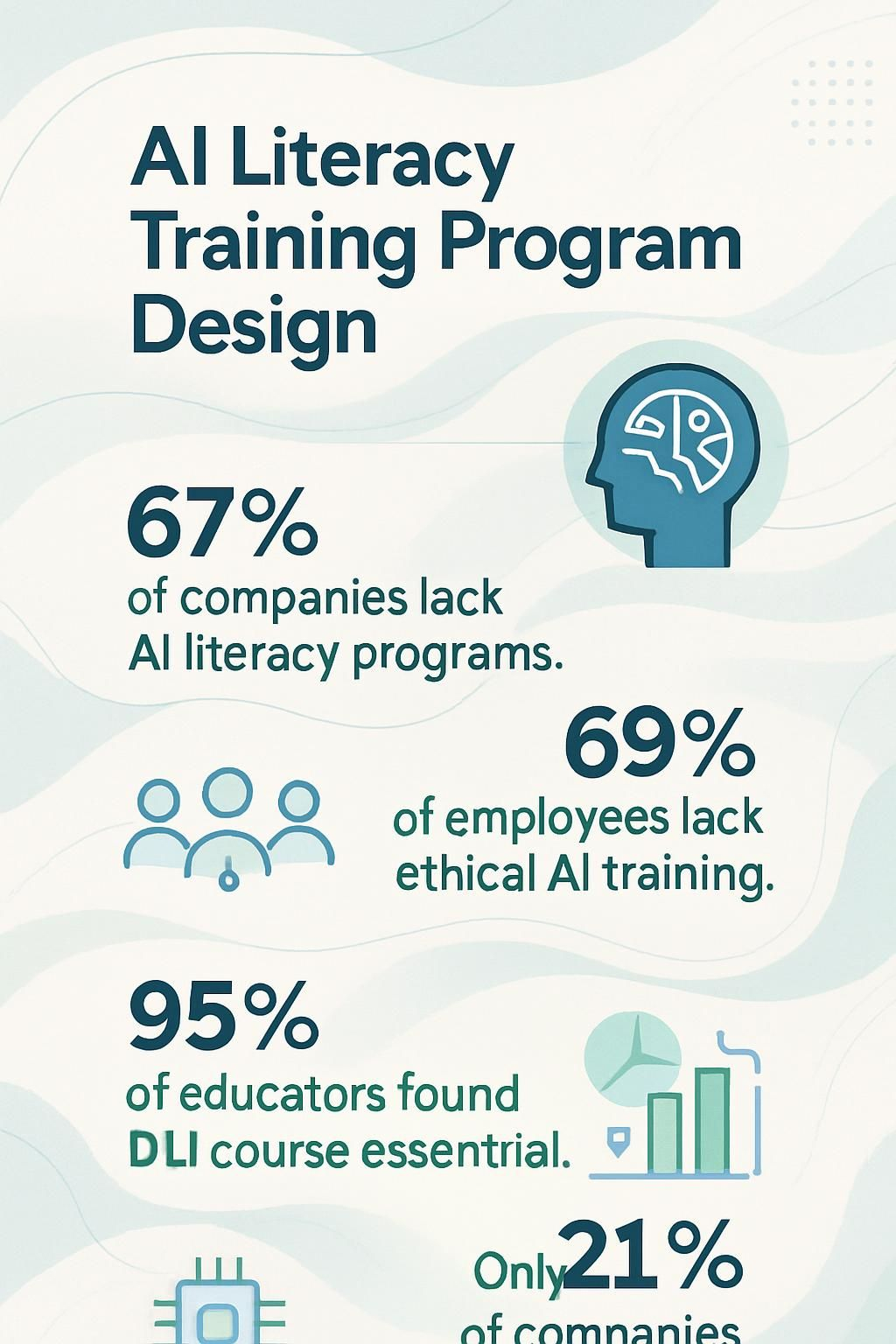AI Literacy Training Program Design


Understanding AI Integration

AI literacy means knowing how to use and understand artificial intelligence tools wisely. This skill gap affects students, teachers, and business leaders alike. Recent data shows only 21% of companies have formal AI governance policies, while 69% of workers lack training on ethical AI use.
The Digital Learning Institute tackles this problem with their Professional Certificate in AI Literacy, which has helped over 4,000 students gain essential skills.
Effective AI literacy programs cover four key areas: foundational concepts, ethical implications, practical applications, and real-world exercises. These programs create Communities of Practice where participants can experiment with AI tools in their work roles.
The training spans multiple stakeholder groups from classrooms to boardrooms, with special attention to making content accessible across diverse populations.
As an AI & Automation Strategist who has built over 750 workflows and generated $200M for partners, I have directly observed how proper AI education transforms businesses.
AI literacy isn't just about technology. It's about creating smart humans who use smart machines.
Key Takeaways
- 67% of companies lack proper AI literacy programs despite growing demand for these skills, creating a knowledge gap that affects organizations of all sizes.
- Effective AI literacy programs require three core components: foundational concepts, hands-on practice with real tools, and ethical frameworks that address the fact that 69% of employees lack training on ethical AI usage.
- Different audiences need specific approaches - students benefit from 15-minute sessions and project-based assessments, while educators can join programs like the DLI course with 11 modules that 95% of graduates found essential.
- Only 21% of companies have AI governance policies in place, putting most businesses at risk when implementing AI tools without proper ethical guidelines.
- The upcoming "AI Literacy in Action" event on February 27, 2025, will feature experts Danny Scuderi and Jamie Nuez sharing practical strategies specifically for educators.

Understanding the Need for AI Literacy

AI literacy has become as essential as reading was in the industrial age - most people lack even basic skills to work with these tools effectively.
Addressing the knowledge gap in AI
Most business leaders face a massive AI knowledge gap right now. You might be nodding along in meetings about "machine learning this" and "neural networks that," but secretly Googling terms under the table.
Don't worry, you're not alone! Our data shows this gap exists across organizations of all sizes, from startups to Fortune 500 companies. The problem isn't just about understanding technical jargon; it's about grasping how AI actually solves real business problems.
Many professionals lack the basic AI literacy needed to make smart decisions about implementation, leading to costly mistakes or missed opportunities.
The biggest risk in AI isn't the technology itself, but the knowledge gap between those who understand it and those who must make decisions about it. - Reuben Smith
This knowledge gap creates a digital divide that grows wider each day as AI tech speeds ahead. Tech-savvy business owners need practical training that goes beyond buzzwords to build actual skills.
A well-designed AI literacy program tackles this by focusing on measurable learning objectives tied to business outcomes. The program must include both foundational concepts and hands-on practice with AI tools that matter to your specific industry.
Let's look at who needs this training most in your organization.
Identifying key stakeholders (students, educators, professionals)
AI literacy isn't just another tech buzzword to add to your collection. Like teaching a teenager to drive, we need to know exactly who's getting behind the wheel before we hand over the keys to artificial intelligence.
- Students represent the primary stakeholders who directly benefit from AI literacy programs. Research shows they specifically express needs for relevant AI skills that will prepare them for future careers where automation and machine learning will be commonplace.
- Educators serve as the critical implementation force, with teachers consistently ranking professional development in AI education as a top priority according to stakeholder interviews.
- School administrators control resource allocation and must balance AI integration with existing curriculum demands and budget constraints.
- Policymakers shape the regulatory landscape for AI in education, actively seeking clear frameworks for implementing AI technologies in schools as highlighted in Nigerian stakeholder studies.
- Parents influence adoption rates through their concerns about screen time, data privacy, and the changing nature of education their children receive.
- Tech industry professionals offer real-world expertise and can provide insights into which AI skills will truly matter in the workplace.
- Local business owners become valuable partners by offering internships and project opportunities where students can apply their AI knowledge to actual business problems.
- Community organizations can extend AI literacy beyond classroom walls, particularly important for reaching adult learners and underserved populations.
- Higher education institutions shape curriculum standards that K-12 programs often align with for college readiness.
- Special education specialists help adapt AI literacy programs for students with different learning needs and abilities.
- Curriculum developers translate complex AI concepts into age-appropriate, engaging learning materials that support skill acquisition across different grade levels.
- IT staff maintain the technical infrastructure needed for hands-on AI education and troubleshoot inevitable technical glitches.
Want To Be In The Inner AI Circle?
We deliver great actionable content in bite sized chunks to your email. No Flim Flam just great content.

Core Components of an AI Literacy Training Program
A solid AI literacy program needs three essential building blocks to work. First, you need clear lessons on AI basics that don't make people's brains explode with techno-babble, then actual practice with real tools, and finally, straight talk about the ethical stuff that matters.
Foundational AI concepts and principles
Let's face it, AI isn't just fancy robot butlers and talking toasters (though that would be cool). The real foundation of AI literacy starts with grasping what these systems can actually do.
Tech-savvy folks need to understand machine learning basics, how AI processes data, and where the limitations exist.
I've seen too many business owners jump into AI tools without knowing the difference between supervised and unsupervised learning, like trying to play Minecraft without knowing how to craft!
The seven key competencies for AI literacy go beyond just knowing what buttons to push. They include recognizing AI capabilities, understanding algorithmic transparency, and applying data governance principles in real-world situations.
My work with over 750 workflow automations has taught me that business leaders who grasp these concepts make smarter implementation decisions.
Think of these foundational elements as your tech skill tree in an RPG, unlocking more powerful abilities as you level up your understanding. Next, we'll explore how hands-on engagement with AI tools transforms abstract concepts into practical business advantages.
Hands-on engagement with AI tools
Getting your hands dirty with AI tools beats reading about them any day. Think of it like learning to ride a bike: you can watch YouTube tutorials for hours, but nothing replaces actually sitting on the seat and pedaling.
- Interactive AI workshops focusing on "Introduction to Generative AI" help business leaders grasp core concepts through practical application rather than theory alone.
- Prompt engineering sessions where participants craft and refine AI instructions, seeing immediate results and learning what works through trial and error.
- Real-world problem-solving exercises using AI tools relevant to your specific industry challenges create meaningful learning experiences.
- Guided exploration of AI platforms like ChatGPT, Midjourney, or industry-specific tools with structured tasks that build confidence gradually.
- Collaborative AI projects where teams tackle actual business problems using AI solutions, reinforcing learning through practical application.
- Role-playing scenarios that simulate customer interactions or operational challenges solved with AI assistance build practical skills.
- AI tool comparison activities where participants test different solutions for the same task and evaluate strengths and limitations firsthand.
- Error analysis exercises teaching participants to recognize and fix common AI mistakes, building critical thinking skills.
- Customized training modules based on ISTE's "AI Explorations for Educators" framework adapted for business contexts.
- Data preparation workshops showing how to format and clean information for optimal AI processing results.
- Ethical decision-making simulations using real business cases where AI applications raise privacy, bias, or transparency concerns.
- Regular skill-building challenges that increase in complexity as participants gain confidence with AI tools.
- Practical documentation exercises where participants create standard operating procedures for AI tool usage in their organization.
- Peer teaching opportunities allowing participants to demonstrate newly acquired skills to colleagues, reinforcing their own learning.
- Implementation planning sessions that bridge the gap between training and actual workplace application of AI tools.
Interactive modules such as embedded quizzes, polls, and short video clips enhance participant engagement by promoting active learning and immediate feedback. Designing effective training programs requires attention to different learning styles and experience levels.
Ethical considerations and AI governance
Moving from hands-on AI tools to ethical frameworks isn't just a technical shift; it's a responsibility leap. AI ethics focuses on fighting bias and promoting fairness in your systems.
The stats are pretty shocking: 69% of employees lack any training on ethical AI usage. I have observed this directly with clients who bought fancy AI tools but skipped the "how to use this responsibly" part.
It's like handing someone the keys to a Ferrari without mentioning speed limits exist.
Creating a governance framework isn't optional anymore. Only 21% of companies have established AI governance policies, putting most businesses at risk. Your AI literacy program must include clear ethical standards and data governance rules.
This means teaching teams how to spot bias in datasets, question algorithmic decisions, and align AI projects with company values. Leadership plays a crucial role here, as executives must connect AI initiatives to organizational goals while maintaining ethical guardrails.
At WorkflowGuide, we've found that companies who build these ethical foundations see better adoption rates and fewer costly AI mistakes down the road.
Designing Training for Different Audiences
Training programs must speak directly to their audience, whether they're tech-savvy CEOs or classroom teachers just starting their AI journey.
Different groups need different approaches - students crave hands-on AI projects with immediate feedback, while business leaders want clear frameworks for implementation and ROI measurement.
Tailored programs for students
Students need AI literacy programs that match their learning styles and knowledge levels. Our free 4-lesson curriculum unit gives students practical AI skills without overwhelming them with technical jargon.
- Quick-hit learning sessions that respect busy schedules - Each AI literacy session runs just 15 minutes, perfect for today's attention spans while still delivering meaningful content.
- Hands-on workshops like "Introduction to Generative AI" that let students create with AI tools rather than just reading about them.
- Real-world problem solving exercises where students apply AI concepts to issues they actually care about, making abstract ideas concrete.
- Collaborative learning opportunities that pair students with tech companies and AI experts for mentorship and industry insights.
- Customized difficulty levels that adjust based on prior tech exposure, so nobody feels lost or bored during the training.
- Project-based assessments instead of traditional tests, allowing students to demonstrate AI literacy through creation rather than memorization.
- Multi-format content delivery including videos, interactive demos, and text resources to accommodate different learning preferences.
- Peer teaching components where tech-savvy students help explain concepts, reinforcing their own knowledge while building leadership skills.
- Ethics-focused discussions that prompt students to consider the social impact of AI tools before they start using them.
- Progress tracking systems that show measurable improvement in both theoretical understanding and practical AI application skills.
Professional development for educators and leaders
AI literacy training requires specific approaches for those who teach others. Our workshops like "Prompt Engineering 101 for Educators" tackle this head-on with practical skills that transfer to real classrooms.
- Leadership workshops focus on strategic AI implementation rather than just tool mastery. These sessions help principals and department heads create school-wide AI policies that protect student data while encouraging innovation.
- Hands-on certification programs give educators recognized credentials. The DLI course offers 11 comprehensive modules covering AI fundamentals, ethical considerations, and practical applications that 95% of 4,000+ graduates called "essential."
- Peer learning circles allow teachers to share AI successes and failures in a judgment-free zone. Monthly meetups create accountability and build confidence through group problem-solving.
- Custom curriculum design labs help educators adapt AI tools to their specific subject areas. Math teachers learn different applications than English teachers, with each receiving subject-specific prompts and lesson plans.
- Ethics boot camps tackle the thorny issues of AI in education head-on. Teachers learn to spot AI-generated work, create fair use policies, and guide students through responsible AI use.
- Professional Certificate programs provide formal recognition valued by global employers. These credentials appear on LinkedIn profiles and resumes, boosting career advancement opportunities.
- Simulation exercises put leaders in realistic scenarios requiring AI-informed decisions. This practical approach builds confidence for real-world implementation challenges.
- Train-the-trainer programs create internal AI champions who spread knowledge throughout organizations. This multiplier effect makes training dollars stretch further while building institutional knowledge.
- The upcoming "AI Literacy in Action" event on February 27, 2025, features experts Danny Scuderi and Jamie Nuez sharing practical strategies. This professional development opportunity focuses specifically on supporting educators.
- Skill acquisition tracking helps measure ROI on training investments. Leaders can see which skills transfer to classroom practice and adjust future training accordingly.
Strategies to Overcome Common Challenges
AI literacy training faces real obstacles that need practical solutions. You need smart strategies to break down complex AI concepts into bite-sized chunks that anyone can grasp, regardless of their technical background.
Simplifying complex AI concepts
AI terminology can be challenging for many business owners to grasp. At WorkflowGuide.com, we simplify AI concepts using the four domains of our literacy framework: functional, ethical, rhetorical, and pedagogical.
Learning AI is similar to progressing in a video game. You begin with basic concepts (what machine learning actually does) before advancing to more complex topics (neural networks).
We have discovered that comparing AI algorithms to familiar business processes helps tech-savvy leaders understand advanced ideas more quickly. For instance, a recommendation engine functions much like your top salesperson who remembers customer preferences.
Our competency framework organizes AI knowledge into progressive levels, making it manageable. We avoid unnecessary technical jargon and concentrate on practical applications in real business scenarios.
One local HVAC company owner shared, "I now understand how predictive maintenance works because you compared it to checking my truck's oil regularly." The framework offers clear learning objectives that progress from foundational to advanced understanding.
This method has enabled business leaders to implement AI tools with confidence instead of confusion. No computer science degree is necessary!
Ensuring accessibility and scalability
Scaling AI literacy programs demands both technical smarts and human-centered design. I have directly observed how AI tools like real-time captioning and text-to-speech functions can transform learning experiences for everyone.
My team at LocalNerds.co once built a training program that flopped because we forgot the basics: not everyone learns the same way!
Think of it like installing ramps alongside stairs, just digital ones. Making your AI literacy program both accessible and scalable means embracing assistive technologies while meeting WCAG and ADA standards. The cool part? These aren't just compliance checkboxes.
Features that help users with disabilities often improve the experience for everyone through enhanced user engagement. For example, AI-powered adaptive learning systems adjust difficulty based on progress, keeping both newbies and tech wizards engaged.
Emotional intelligence components in these systems can even detect frustration and offer extra support before someone rage-quits your training.
Overcoming AI Resistance in Organizations
AI resistance lurks in many companies like that one weird bug in your code that keeps crashing the system. Research shows this resistance has three distinct dimensions: fear of AI, doubts about its effectiveness, and negative emotional responses.
I have observed this directly with clients who initially crossed their arms and gave me the "this won't work here" look. Job security fears and mistrust in AI systems top the list of employee concerns, creating a digital transformation roadblock that makes herding cats seem simple.
Breaking down this resistance requires a multi-pronged approach focused on workforce adaptation and organizational culture shifts. Start by creating safe spaces for technological reflection where teams can honestly evaluate AI's impact on their roles.
Human-AI augmentation strategies work better than replacement narratives, showing how AI tools complement human skills rather than compete with them. The most successful companies improve AI accessibility across departments and build trust in technology through transparent training programs.
Employee engagement skyrockets when people feel like collaborators in the AI journey rather than victims of it.
A recent case study illustrates how a mid-sized enterprise overcame employee concerns and achieved measurable improvements in decision making and skills development in digital literacy.
Conclusion
Building an AI literacy program requires thoughtful planning. You need clear goals, engaging content, and hands-on practice with real AI tools. Different audiences need different approaches, from students needing foundational concepts to professionals requiring application-focused training.
The main challenge is making complex AI concepts simple without losing their essence. Resistance often stems from fear of the unknown, so your program should address concerns directly with ethical frameworks and critical thinking skills.
Start small, measure results, and adjust as needed. Your organization's AI journey begins with literacy, and a well-designed training program guides the way forward.
Additional strategies on addressing skepticism and facilitating AI adoption in organizations are available at Overcoming AI Resistance in Organizations.
FAQs
1. What is an AI literacy training program?
An AI literacy training program teaches people how to understand and work with artificial intelligence tools. It covers basics like machine learning concepts, data analysis, and ethical AI use. These programs help bridge the knowledge gap between tech experts and everyday users.
2. Who should attend AI literacy training?
Anyone who works with or will soon use AI systems should jump on board. This includes business leaders, teachers, healthcare workers, and office staff. The world's changing fast, and staying ahead means knowing how AI fits into your job.
3. How long does a typical AI literacy program last?
Program length varies widely based on depth and goals. Some quick courses wrap up in a day, while deep-dive programs might run for weeks or months. Many companies offer flexible options with self-paced modules so you can learn between other tasks.
4. What topics should a good AI literacy program cover?
A solid program hits the key bases: AI fundamentals, data literacy, ethical considerations, and hands-on practice. It should explain how algorithms work without drowning you in tech talk. The best programs mix theory with real-world examples that stick in your mind.
Still Confused
Let's Talk for 30 Minutes
Book a no sales only answers session with a Workflow Guide
References and Citations
Disclosure: This content is informational and independently produced. The data and experiences mentioned originate from practical expertise at WorkflowGuide.com.
References
- https://iapp.org/news/a/designing-an-ai-literacy-program (2025-01-29)
- https://www.nature.com/articles/s41599-025-04583-8
- https://www.sciencedirect.com/science/article/pii/S2666557324000521
- https://fas.org/publication/teacher-ai-literacy-development/
- https://crl.acrl.org/index.php/crl/article/view/26409/34344
- https://www.ibm.com/think/insights/ai-literacy
- https://iste.org/ai
- https://oliverpatel.substack.com/p/the-ultimate-guide-to-ai-literacy
- https://aigovernance.group/blog/understanding-ai-literacy
- https://www.sciencedirect.com/science/article/pii/S2666920X25000451
- https://www.innovativeeducators.org/products/micro-credential-ai-literacy-essentials-for-college-students
- https://home.edweb.net/webinar/commonsense20250227/
- https://teachingcommons.stanford.edu/teaching-guides/artificial-intelligence-teaching-guide/understanding-ai-literacy
- https://www.mindsmith.ai/blog/ai-and-accessibility-building-inclusive-elearning-content
- https://www.sciencedirect.com/science/article/pii/S1053482224000652



